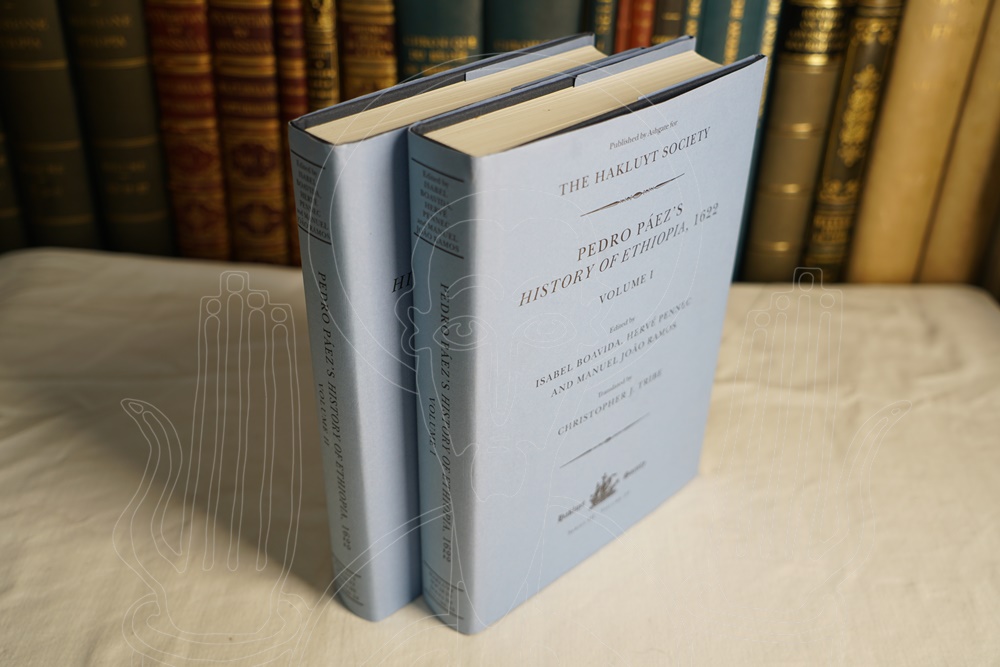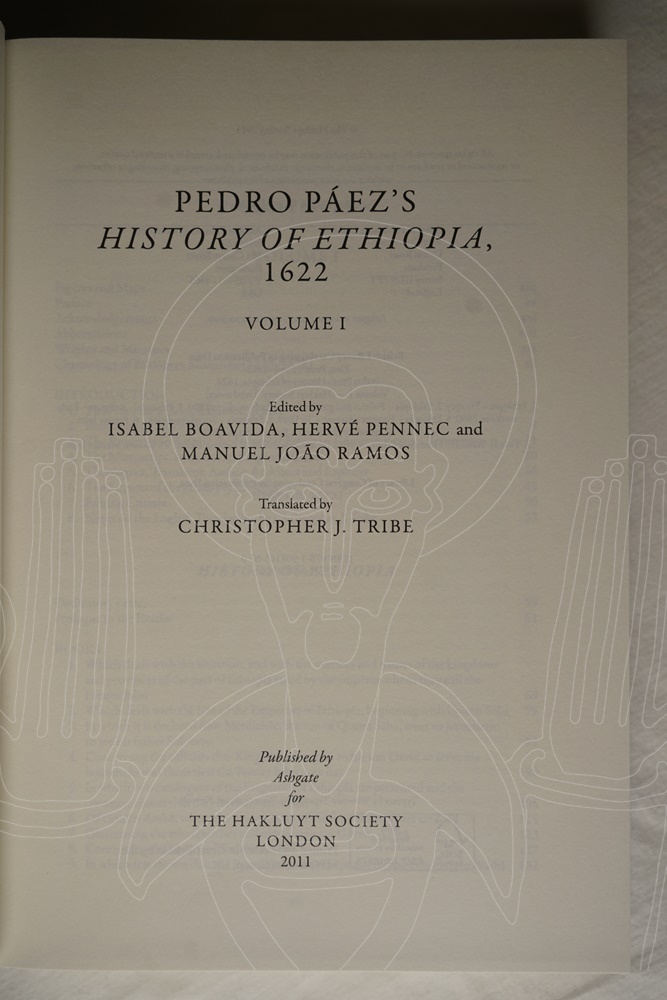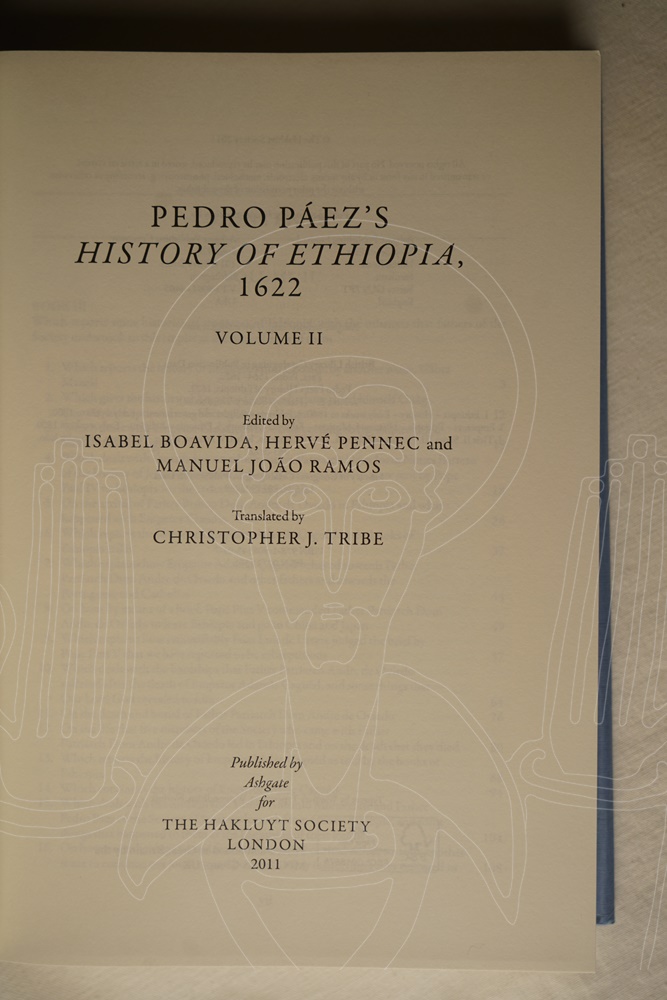Pedro Páez’s History of Ethiopia, 1622.




Édition
Éditeur : Hakluyt Society
Lieu : London
Année : 2011
Langue : anglais
Description
État du document : bon
Reliure : rigide
Références
Réf. Biblethiophile : 002932
Réf. UGS : 0160300
Première entrée : 1603
Sortie définitive : 1622
COLLATION :
2 vols, 526 p., 440 p., 19 b&w illustrations.
En savoir plus
Notes
Le père jésuite espagnol Pedro Paez parvient, après une première tentative infructueuse, à débarquer à Massaoua le 26 avril 1603. Son œuvre est monumentale, tant au niveau architectural que littéraire. Il meurt le 20 mai 1622 à Gorgora.
Biblethiophile, 22.08.2020
Présentation de l’éditeur
This book, in two volumes, contains an annotated English translation of the História da Etiópia by the Spanish Jesuit missionary priest Pedro Páez (or Pêro Pais in Portuguese), 1564–1622, who worked in the Portuguese padroado missions, first in India and then in Ethiopia, long thought to be the kingdom of the legendary Prester John. His history of Ethiopia was written in Portuguese in the last ten years of his life and survives in only two manuscripts. The translation, by Christopher J. Tribe, is based on the new critical edition of the Portuguese text by Isabel Boavida, Hervé Pennec and Manuel João Ramos, which was published in Lisbon in 2008. They are also the editors of this English version.
The History of Ethiopia is an essential source for several areas of study – from the history of the Catholic missions in that country and the relations between the European religious orders, to the history of art and religions; from the history of geographical exploration to the ideological contextualization of the Ethiopian kingdom; from material culture to Abyssinian political and territorial administration; and from an analysis of local circumstances to changes in human ecology in the Horn of Africa and the Indian Ocean. It is a repository of empirical knowledge on the political geography, religion, customs, flora and fauna of Ethiopia. It combines travel narrative with a historico-ethnographic monograph, and is a chronicle of the activities of Jesuit missionaries in their Ethiopian mission. It also reworks a wide variety of documents, including the first translations into a European language of a number of Ethiopian literary texts, from royal chronicles to hagiographies.
It complements other early accounts of Ethiopia by Ludovico de Varthema, Francisco Alvares, Castanhoso, Bermudez, Arnold von Harff, Manoel de Almeida, Bahrey, Alessandro Zorzi, Jerónimo Lobo and Václav Prutky, all published by The Hakluyt Society.
Source: premier rabat de jaquette
Avis
« [son] Histoire de l’Ethiopie constitue un recueil d’informations exceptionnelles ». Jean-François Faü, Aethiopica, n°18, 2015, p. 14.
‘The publication of Pedro Páez’s History of Ethiopia makes available a most valuable text for an understanding of the history of Ethiopia and of European missionary activity there in the sixteenth and seventeenth centuries… Once again, the Hakluyt Society has placed students of Ethiopia deeply in its debt.’ Catholic Historical Review.
‘The Hakluyt Society has organized an outstanding international group of critics-Isabel Boavida, Hervé Pennec, and Manuel João Ramos with Christopher J. Tribe’s English translation from Portuguese-to conduct the monumental task of successfully presenting Pedro Páez’s History of Ethiopia with numerous vivid maps and figures, detailed footnotes… Overall, this critical edition by Boavida, Pennec, Ramos, and Tribe is impeccable and exhaustively thorough. It also respects the finery between nuanced readings and in-depth close readings… Thanks to this beautifully designed edition of Pedro Páez’s History of Ethiopia, the so-called mystique and allure surrounding early modern Christian Ethiopia will come to life, opening up a new field of uncharted territory on critical studies about early European contact in sub-Saharan Africa.’ Renaissance Quarterly.
‘Father Pedro Páez’s History of Ethiopia is an invaluable, first-hand account of everyday life in a Jesuit mission to Ethiopia during the opening decades of the 1600s… This elegant and meticulous edition has invigorated the study of Ethiopian history, especially with respect to the land’s political, cultural, and religious developments in the 1600s. By dint of the editors’ and translators’ efforts, future scholars of Ethiopia and of missionary movements the world over will benefit from the richness emanating from Father Pedro Páez’s quill.’ Journal of African History.